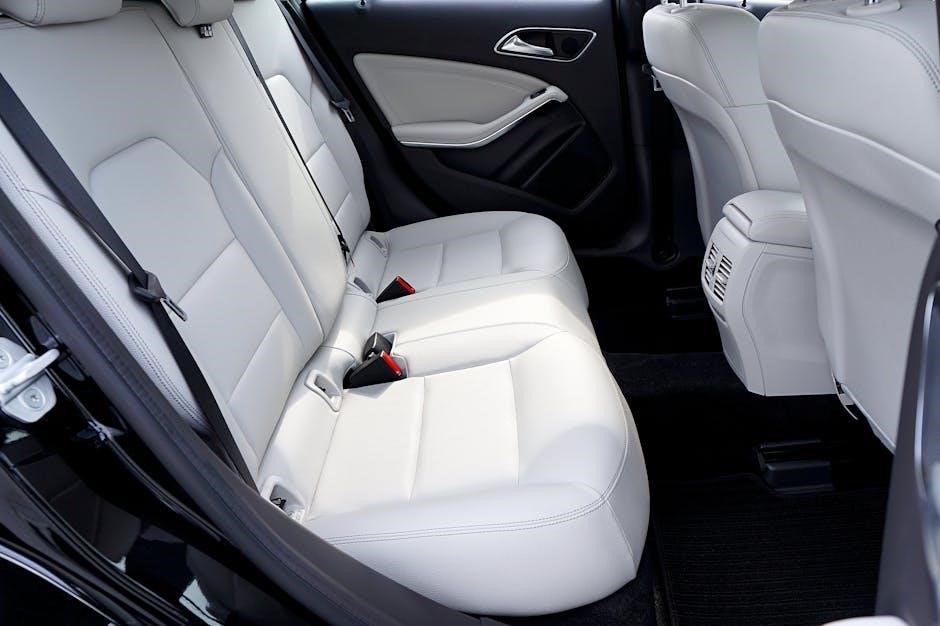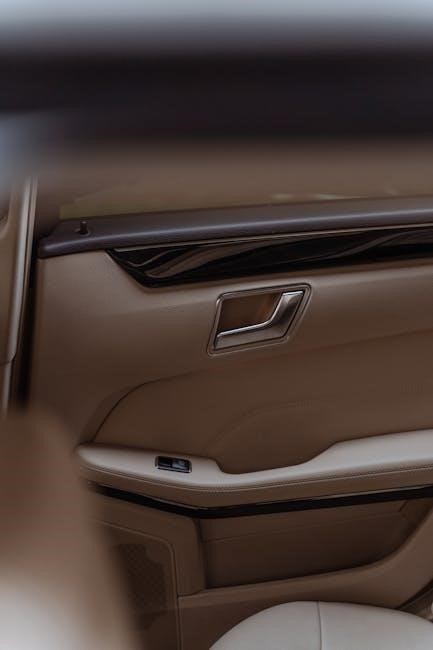Cosco infant car seats are a trusted choice for many parents‚ offering safety‚ ease of use‚ and adaptability. Designed with a focus on comfort and security‚ these seats feature lightweight designs‚ adjustable harness systems‚ and compatibility with LATCH for secure installation. Whether for rear-facing infants or forward-facing toddlers‚ Cosco seats provide reliable protection and peace of mind‚ ensuring your child’s safety as they grow.
1.1 Importance of Following Instructions
Following the instructions for Cosco infant car seats is crucial for ensuring your child’s safety. Proper installation and use guarantee the seat functions as intended during an accident. The manual provides guidelines on correct installation‚ securing the child‚ and adjusting the seat to meet safety standards. Ignoring these steps can lead to improper use‚ reducing the seat’s effectiveness. Additionally‚ the instructions include weight and height limits‚ essential for selecting the right seat for your child’s size. Adhering to these guidelines ensures compliance with safety regulations and maximizes protection. Always refer to the manual for maintenance tips and transition steps to ensure optimal safety and functionality over time.
1.2 Key Features of Cosco Infant Car Seats
Cosco infant car seats are designed with essential features to ensure safety and convenience. They include lightweight designs for easy transport‚ adjustable harness systems for proper fit‚ and LATCH compatibility for secure installation. Many models offer a compact size‚ ideal for smaller vehicles‚ while maintaining comfort for infants and toddlers. The seats often feature multiple recline positions for optimal positioning and a snug fit in various vehicles. Additionally‚ they come with easy-to-clean fabric and intuitive adjustment mechanisms‚ making maintenance and use hassle-free. These features ensure that Cosco car seats provide both safety and practicality‚ catering to the needs of growing children and busy parents alike.
Safety Standards and Compliance
Cosco infant car seats meet rigorous federal safety standards‚ ensuring reliable crash performance and proper labeling for clear guidance‚ giving parents confidence in their child’s protection.
2.1 Federal Safety Standards for Infant Car Seats
Cosco infant car seats adhere to strict federal safety standards‚ ensuring they meet rigorous testing requirements for crashworthiness‚ structural integrity‚ and labeling clarity. These standards mandate that all car seats protect children from injury in the event of a crash‚ with specific guidelines on weight and height limits‚ harness strength‚ and installation methods. Compliance with these regulations is verified through rigorous testing‚ providing parents with assurance that their child’s car seat meets the highest safety benchmarks. The Federal Motor Vehicle Safety Standards (FMVSS) ensure that Cosco car seats are designed to safeguard children effectively in various collision scenarios‚ offering reliable protection and peace of mind.
2.2 Weight and Height Limits for Cosco Infant Car Seats
Cosco infant car seats are designed to accommodate children within specific weight and height ranges to ensure optimal safety and proper fit. For rear-facing mode‚ the seats typically support infants weighing between 5 and 40 pounds‚ with a maximum height of 40 inches. Forward-facing mode extends the weight limit up to 50 pounds and 50 inches in height. Adhering to these limits is crucial to ensure the seat’s structural integrity and the child’s protection in the event of a crash. Parents should always consult the user manual and product labels to verify the exact specifications for their particular Cosco car seat model.

Unboxing and Initial Setup
When unboxing your Cosco infant car seat‚ inspect the contents for damage and ensure all components are included. Carefully review the manual before installation to ensure proper setup and safety.
3.1 What to Expect in the Box
When you unbox your Cosco infant car seat‚ you’ll typically find the car seat itself‚ a detachable base‚ LATCH connectors‚ harness straps‚ and a user manual. The car seat is designed to be lightweight and portable‚ with a cushioned interior for your baby’s comfort. The base is sturdy and includes LATCH straps for secure installation. The manual is comprehensive‚ covering installation‚ safety guidelines‚ and maintenance tips. Ensure all components are included and undamaged before use. The design emphasizes safety and ease of use‚ making it a reliable choice for protecting your child on the go. Always verify the contents match what’s listed in the manual.
3.2 Checking for Damage or Defects
Before using your Cosco infant car seat‚ inspect it thoroughly for any damage or defects. Check the seat’s exterior and interior for cracks‚ frayed straps‚ or loose parts. Ensure the harness‚ buckles‚ and LATCH connectors are in perfect condition. Review the user manual for any specific instructions on pre-use inspections; Look for the manufacture date on the seat to confirm it matches the manual’s guidelines. If the seat arrives without padding or wrapping‚ verify that this is standard and not a sign of damage. Any defects or damage could compromise safety‚ so contact Cosco customer support immediately if you find issues.
Understanding the User Manual
The Cosco infant car seat manual provides essential guidance for installation‚ safety features‚ and troubleshooting. Reading it thoroughly ensures correct usage and optimal protection for your child’s safety.
4.1 Navigating the Instruction Booklet
The Cosco infant car seat instruction booklet is organized into clear sections‚ making it easy to find specific guidance. It starts with an introduction to the car seat’s features‚ followed by detailed installation steps for both rear-facing and forward-facing modes. The manual also includes safety precautions‚ weight and height limits‚ and troubleshooting tips. Diagrams and symbols are used to illustrate key points‚ while important warnings are highlighted to ensure user awareness. By following the manual’s structured approach‚ parents can confidently install and use the car seat correctly‚ ensuring their child’s safety and comfort. Regular updates and specific model guides are also available online for additional support.
4.2 Important Warnings and Symbols
The Cosco infant car seat manual includes critical warnings and symbols to ensure safe usage. These alerts highlight essential safety precautions‚ such as proper installation‚ weight and height limits‚ and correct harness positioning. Symbols like the “Do Not” icon indicate actions to avoid‚ while others emphasize proper usage. Warnings about expiration dates and avoiding unapproved accessories are also prominent. The manual stresses that failure to follow instructions can compromise safety. Parents are urged to check for damage and ensure the seat is not past its expiration date. These warnings are presented in both text and visual forms to maximize understanding and compliance‚ ensuring the car seat performs as intended in protecting the child.

Installation Steps for Rear-Facing Mode
Place the base in the vehicle seat‚ secure it with LATCH or a seatbelt‚ attach the car seat‚ and ensure it’s level. Check for a snug fit.
5.1 Preparing the Vehicle Seat
Before installing your Cosco infant car seat in rear-facing mode‚ ensure the vehicle seat is properly prepared. Move the vehicle seat as far back as possible and adjust the angle to ensure the car seat base will lie flat. Clean the area to prevent debris from interfering with the installation. If your vehicle has adjustable headrests or seat cushions‚ position them to accommodate the car seat without obstruction. Finally‚ locate the LATCH anchors or seatbelt to secure the base‚ ensuring compatibility with your vehicle’s seating configuration. Refer to your vehicle’s manual for specific instructions on preparing the seat for car seat installation.
5.2 Securing the Base with LATCH or Seatbelt
To secure the Cosco infant car seat base‚ choose between the LATCH system or a vehicle seatbelt. For LATCH‚ locate the lower anchors in your vehicle and attach the base’s connectors‚ ensuring they click firmly into place. Tighten the straps until the base is snug and even. If using a seatbelt‚ thread the belt through the base’s designated path‚ then buckle and tighten by pulling the strap firmly. Ensure the base is level and doesn’t move more than an inch side-to-side or front-to-back. Refer to your vehicle and car seat manuals for specific guidance‚ as improper installation can compromise safety. Always double-check the tightness before placing your child in the seat.
Installation Steps for Forward-Facing Mode
Transition your child to forward-facing once they outgrow rear-facing limits. Adjust the harness to fit snugly‚ ensuring the shoulder straps align with their shoulders. Secure the seat using either the LATCH system or a seatbelt‚ tightening firmly to prevent movement. Always consult the manual for specific forward-facing installation guidance and verify compatibility with your vehicle’s seating configuration.
6.1 Transitioning to Forward-Facing
Transitioning your child to forward-facing mode typically occurs when they exceed the rear-facing weight or height limits‚ usually around 40 pounds or 40 inches tall. Before making the switch‚ ensure the car seat is designed for forward-facing use and adjust the harness to fit snugly‚ with shoulder straps aligned at or above your child’s shoulders. Move the seat to the forward-facing position and secure it using the LATCH system or vehicle seatbelt‚ tightening until the seat is firmly in place. Always verify the seat’s level indicator to ensure proper installation and consult the manual for specific guidance. This transition marks an important milestone in your child’s safety and comfort while traveling.
6.2 Adjusting the Harness and Headrest
Properly adjusting the harness and headrest ensures your child’s safety and comfort in forward-facing mode. Begin by loosening the harness straps and height adjustment mechanism. Move the headrest up or down to align the shoulder straps with your child’s shoulders‚ ensuring they sit snugly without twisting. Tighten the harness until it fits firmly against your child’s body‚ and check that the chest clip is at armpit level. The headrest should be positioned to support your child’s head without forcing it forward. Regularly adjust these components as your child grows‚ and always refer to the user manual for specific guidance on your Cosco car seat model.

Using the LATCH System
The LATCH system simplifies secure car seat installation using built-in vehicle anchors. Cosco seats include LATCH connectors for easy attachment‚ ensuring a stable and safe fit for your child.
7.1 What is the LATCH System?
The LATCH system‚ or Lower Anchors and Tethers for Children‚ is a built-in vehicle feature designed to simplify car seat installation. It consists of two lower anchors located in the vehicle seat and a tether anchor for forward-facing seats. Cosco car seats are equipped with LATCH connectors that attach directly to these anchors‚ eliminating the need for seatbelts. This system ensures a secure and stable fit‚ reducing installation errors and enhancing child safety. It is compatible with most vehicles and provides a convenient solution for parents to install car seats correctly. Always check your vehicle manual to locate LATCH anchors.
7.2 Attaching and Tightening LATCH Straps
To attach and tighten LATCH straps for your Cosco infant car seat‚ locate the lower anchors in your vehicle. Align the LATCH connectors on the car seat base with the vehicle anchors and snap them into place. For forward-facing seats‚ attach the top tether to the vehicle’s tether anchor. Pull the straps to remove slack‚ then tighten by pulling the strap or using the tightening mechanism on the base. Ensure the base is secure and cannot move more than one inch side-to-side or front-to-back. Check tightness by grasping the seat firmly at the belt path. Refer to your vehicle and car seat manuals for specific instructions‚ as models may vary. Always verify the installation is snug and even‚ adjusting as needed for your child’s safety. Regularly monitor and tighten the straps as your child grows to maintain a proper fit.

Vehicle Compatibility
Vehicle compatibility is crucial for proper car seat installation. Always check your vehicle’s specifications to ensure the Cosco infant car seat fits securely‚ using LATCH or seatbelt systems. Refer to both the car seat and vehicle manuals for guidance.
8.1 Checking Vehicle Compatibility
Before installing a Cosco infant car seat‚ ensure it fits your vehicle by measuring the available space and checking the seating configuration. Refer to your vehicle’s manual to locate LATCH anchors or alternative installation methods. Rear-facing seats require adequate space to recline properly‚ while forward-facing seats need a clear path for the harness. Test the car seat in your vehicle to confirm it fits snugly without obstructing other passengers. For smaller vehicles‚ consider compact models like the Cosco Scenera. Always verify compatibility with your specific vehicle make and model to ensure safe and proper installation‚ as outlined in the car seat manual.
8.2 Solving Space Issues in Smaller Vehicles
For smaller vehicles‚ selecting a compact infant car seat like the Cosco Scenera can help optimize space. Consider seats with a narrower footprint or adjustable bases that fit snugly. Positioning the car seat in the middle of the backseat often provides more room. If space is tight‚ check if the seat can be installed at an angle or use a seatbelt instead of LATCH for better fit. Some models allow for a more upright installation to save legroom. Always ensure proper alignment and tightness for safety. Portable and lightweight designs also make handling easier in smaller cars‚ while maintaining essential safety features for your child’s protection and comfort.

Adjusting the Car Seat
Adjusting the car seat involves tightening the harness‚ reclining for comfort‚ and ensuring proper fit. Follow the manual to customize the seat for your child’s safety and comfort.
9.1 Adjusting the Harness Straps
Adjusting the harness straps ensures your child’s safety and comfort. Always refer to the Cosco infant car seat manual for specific guidance. Tighten the straps snugly‚ ensuring no slack exists. The harness should fit securely over your child’s shoulders‚ with the chest clip at armpit level. Regularly check the fit as your child grows‚ ensuring proper positioning and snugness. If the straps are too loose or too tight‚ adjust them accordingly. Never overtighten‚ as this could cause discomfort. Properly adjusted harness straps are essential for maximizing safety in the event of sudden stops or collisions. Ensure the straps are free from twists and lie flat against your child’s body for optimal protection.
9.2 Reclining the Seat for Comfort and Safety
Reclining the Cosco infant car seat ensures your child’s comfort and safety during travel. Always follow the instructions in the user manual for proper recline adjustment. The seat should be reclined at the recommended angle to support your child’s head and body. Use the recline adjustment feature to find the optimal position‚ ensuring the child remains secure. Check the recline indicator or level to confirm the correct angle. Proper reclining helps prevent your child’s head from tilting forward‚ reducing the risk of discomfort or potential safety hazards. Consult the manual for specific guidance on reclining for different modes‚ such as rear-facing or forward-facing.

Securing the Child
Properly secure your child by buckling the harness and ensuring a snug fit. Always check the harness tightness and adjust as needed.
10.1 Properly Buckling the Child

To ensure your child’s safety‚ always follow the Cosco car seat manual for buckling. Position your child in the seat‚ ensuring their back is flat against the seatback. Place the harness straps over their shoulders‚ making sure they are not twisted. The chest clip should be at armpit level. Buckle the harness‚ ensuring it clicks securely. Tighten the straps until snug‚ checking by trying to pinch the material—if it doesn’t gather‚ it’s too tight. Finally‚ verify the buckle is properly engaged and the child cannot easily unbuckle it. Regularly check the fit as your child grows to maintain optimal safety and comfort.
10.2 Checking the Harness Tightness
After buckling your child‚ ensure the harness is snug by performing the pinch test: try to pinch the harness material at the shoulder. If you can’t pinch any excess fabric‚ it’s properly tightened. Adjust the straps as needed until they fit snugly against your child’s body. The harness should be at or below shoulder level when rear-facing and at or above when forward-facing. Regularly check the tightness‚ as a loose harness can compromise safety. Always adjust the harness while the car seat is in the vehicle to ensure a secure fit. Proper harness tightness is crucial for optimal protection in the event of sudden stops or accidents.

Maintenance and Cleaning
Regularly clean the car seat fabric with mild soap and water‚ avoiding harsh chemicals. Inspect for wear and tear‚ replacing any damaged parts promptly to ensure safety.
11.1 Cleaning the Car Seat Fabric
Cleaning the Cosco infant car seat fabric is essential for maintaining hygiene and longevity. Start by spot-cleaning stains with a soft cloth dampened with mild soap and warm water; Avoid harsh chemicals‚ bleach‚ or abrasive cleaners‚ as they may damage the material. For tougher stains‚ gently scrub with a clean‚ damp cloth‚ then rinse with fresh water. Allow the fabric to air dry completely to prevent mildew. Never machine wash or dry the fabric‚ as it may shrink or lose its fire-resistant treatment. Regular cleaning ensures your child’s safety and comfort while keeping the seat looking its best.
11.2 Inspecting for Wear and Tear
Regularly inspecting your Cosco infant car seat for wear and tear is crucial for ensuring your child’s safety. Check the harness straps for fraying‚ cracks‚ or signs of stretching‚ and ensure all buckles and connectors are functioning properly. Examine the seat’s fabric for stains‚ tears‚ or fading‚ which may indicate exposure to harmful UV light. The base and structural components should be free from cracks or dents. If any damage is found‚ discontinue use and contact Cosco customer service for guidance. Replace the seat immediately if it has been involved in an accident or exceeds the expiration date listed in the manual.
Troubleshooting Common Issues
Troubleshooting common issues with your Cosco infant car seat ensures optimal performance and safety. Address problems like loose installations or tangled straps by consulting the manual or contacting customer support.
12.1 Resolving Installation Problems
Resolving installation issues with your Cosco infant car seat is crucial for your child’s safety. Ensure the base is snug against the vehicle seat using LATCH or a seatbelt. Check the manual for weight limits and proper tightening techniques. If the seat feels loose‚ adjust the straps or anchors. Verify the level indicator is within the acceptable range. If problems persist‚ consult the troubleshooting section of the manual or contact Cosco’s customer service for assistance. Proper installation ensures optimal safety‚ so never skip this step.
12.2 Addressing Harness or Buckle Malfunctions
If you notice issues with the harness or buckle‚ stop using the car seat immediately. Inspect for any visible damage or wear. Clean the buckle with mild soap and water if it’s stiff or dirty. Ensure the harness straps are free from twists and properly routed. If the buckle doesn’t function correctly after cleaning‚ contact Cosco customer support for a replacement. Regularly check the harness and buckle for signs of wear‚ such as fraying or cracks. If a malfunction is detected‚ do not use the seat until it’s repaired or replaced. Always refer to the user manual for guidance on proper maintenance and troubleshooting.
Frequently Asked Questions
- Can the Cosco infant car seat be used on airplanes?
- How long can a child use the Cosco infant car seat?
13.1 Can the Car Seat be Used on Airplanes?
The Cosco infant car seat is generally approved for airplane use‚ but it’s essential to check with your airline for specific guidelines. Ensure the seat fits the aircraft seat dimensions and meets Federal Aviation Administration (FAA) standards. Most Cosco seats are designed for vehicles but can be used on planes if they have a harness and fit securely. You may need to use the seatbelt to install it on the plane. Always consult the airline and your car seat manual for proper installation instructions to ensure your child’s safety during the flight.
13.2 How Long Can a Child Use the Car Seat?

A child can use a Cosco infant car seat until they reach the maximum weight‚ height‚ or age specified in the manual. Typically‚ rear-facing mode is suitable from 5 to 40 pounds (2.3 to 18 kg) and up to 40 inches (101.6 cm) tall. Forward-facing mode can be used until the child reaches 50-65 pounds (22.7-29.5 kg)‚ depending on the model. Always check the manual for exact limits. Ensure your child fits comfortably within these parameters and adjust the seat as needed. Transition to a booster seat when outgrowing the car seat’s height or weight restrictions.
Resources and Support
Cosco offers comprehensive support through their official website‚ including user manuals‚ installation guides‚ and customer service contact. Visit consumercare.coscokids.com for assistance or local car seat inspection stations near you.
14.1 Contacting Cosco Customer Service
For assistance with your Cosco infant car seat‚ visit the official website at consumercare.coscokids.com; Here‚ you can access user manuals‚ troubleshooting guides‚ and contact information. Customer service is available to address installation questions‚ warranty inquiries‚ or product concerns. You can reach them via phone or email for personalized support. Additionally‚ the website offers a wealth of resources‚ including FAQs and installation tips‚ to help you use your car seat confidently. Cosco’s dedicated team ensures your questions are answered promptly‚ providing peace of mind for your child’s safety and comfort on the go.
14.2 Finding Local Car Seat Inspection Stations
To ensure your Cosco infant car seat is installed correctly‚ consider visiting a local car seat inspection station. These stations are staffed by certified technicians who can verify proper installation and address any concerns. Many communities offer free or low-cost inspections‚ often sponsored by local fire departments‚ hospitals‚ or safety organizations like Safe Kids Worldwide. Visit the consumercare.coscokids.com website or contact your local highway safety office to find an inspection station near you. These services are invaluable for confirming your car seat is safe and properly fitted‚ giving you peace of mind while traveling with your child.
